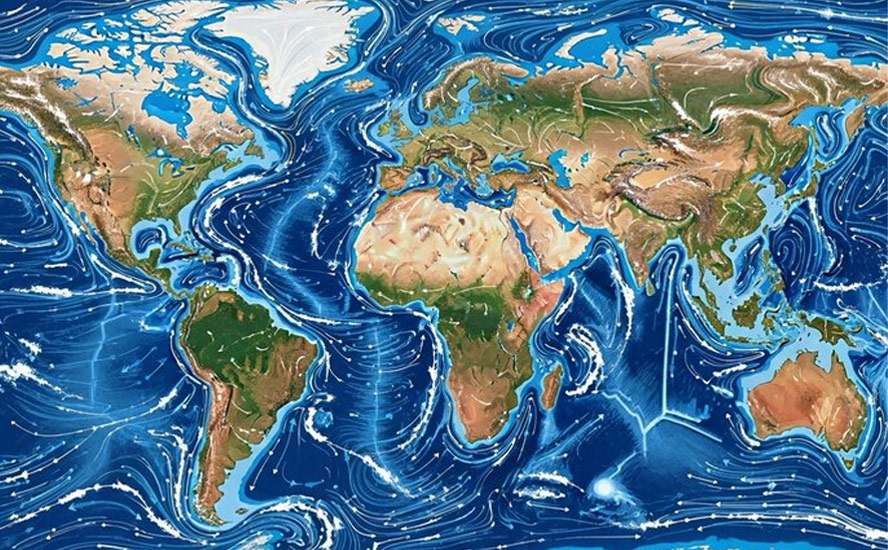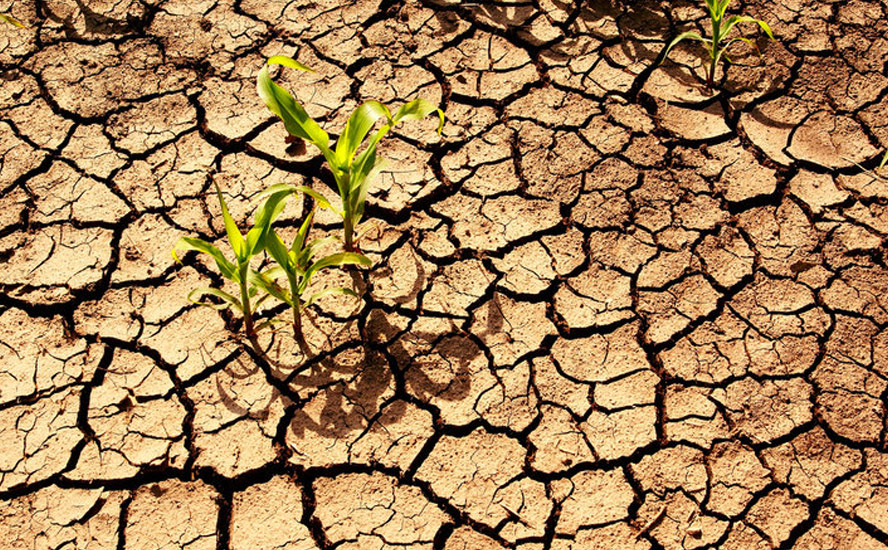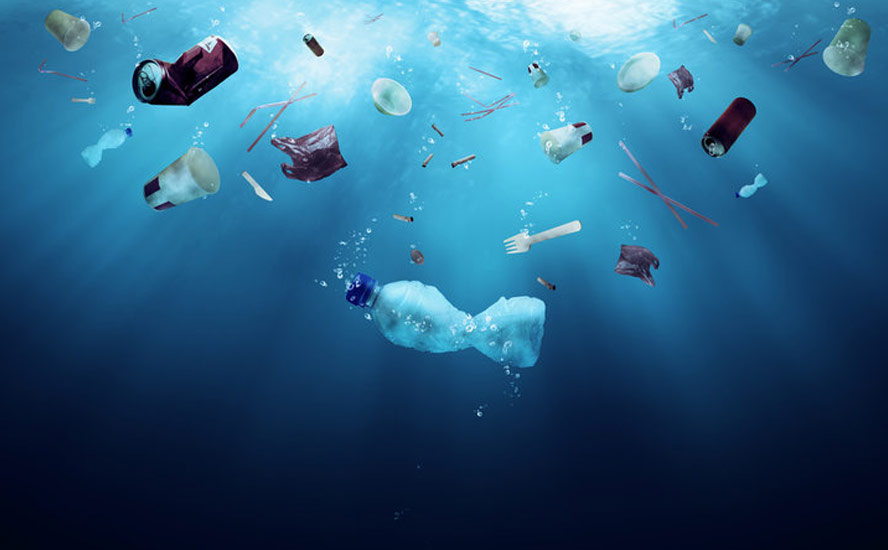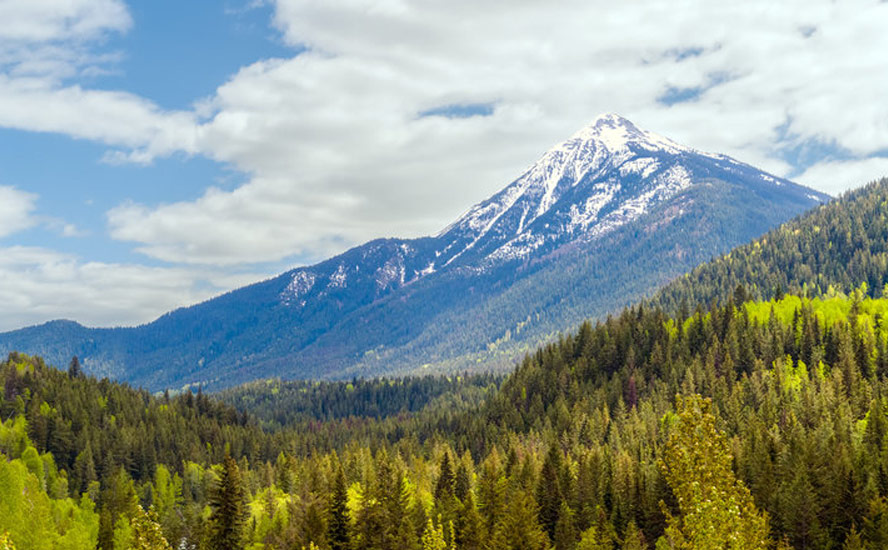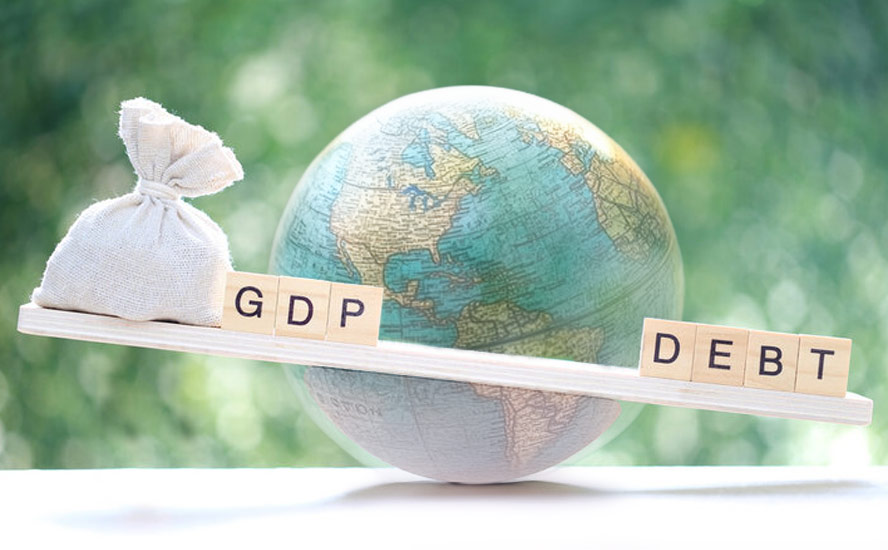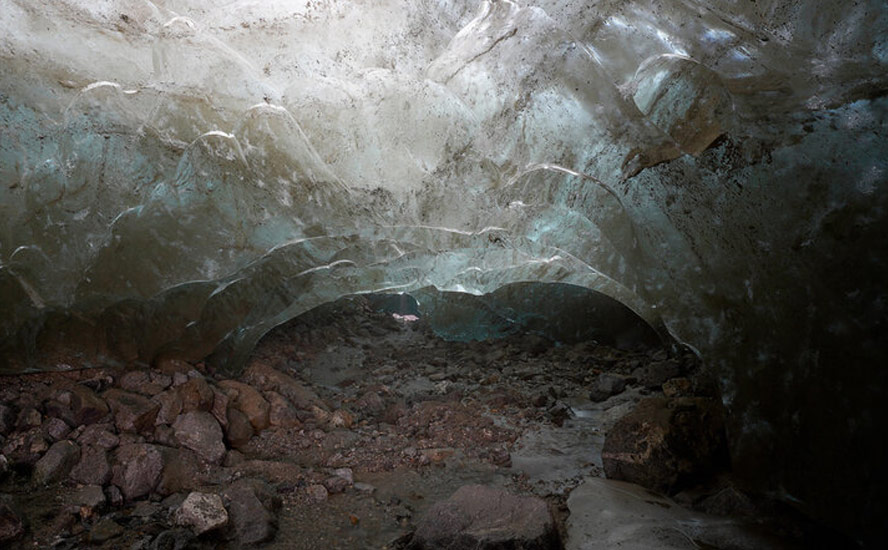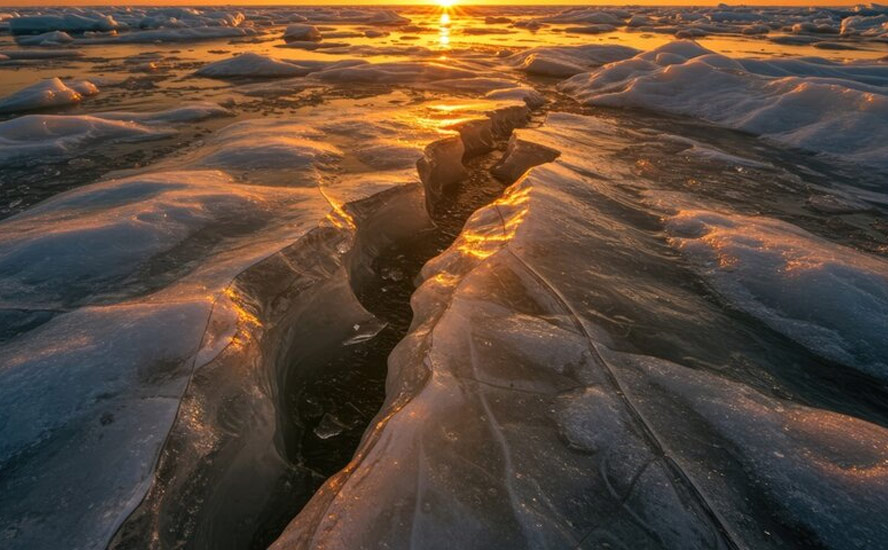LNG: Another environmental disaster coming to BC

2018.10.21
A new liquefied natural gas industry in British Columbia that would be so successful, it would pay off the provincial debt, turned out to be just fairy dust sprinkled by ex-BC Premier Christy Clark. “We’re doing this for our kids,” enthused a folksy-sounding Clark geared up in coveralls and a hardhat, on the campaign trail that won her the premiership in 2013. The prospective LNG projects, which at one time totalled 20, would use natural gas piped from BC’s northeast gas fields to terminals on the BC coast, then shipped on tankers for energy-hungry markets in Asia.

LNG tankers too dangerous for East Coast, but OK for BC?
One by one, however, the projects collapsed amid low natural gas prices (BC was late to the game and faced a wave of new export capacity, including LNG produced from Australia and the US). The latest was a decision by Petronas in 2017 to pull the plug on its $36 billion Pacific NorthWest LNG project in Prince Rupert.
Defenders said the industry is cyclical and prices would come back, making BC-based facilities attractive to oil and gas companies due to the shorter shipping route to Asia versus terminals in the States.
The departure of Petronas left just three potential project candidates: LNG Canada in Kitimat, a $40-billion project consisting of Asian companies led by Shell, and needing a 650-km gas pipeline; Kitimat LNG, a JV between Chevron and Woodside, an Australian company, that includes a 463-km pipeline; and Woodfibre LNG in Squamish, which has an investment decision but no construction date.
Now the LNG promise, considered by most to be dead, has been revived, thanks to a final investment decision by Shell and its partners to go ahead with LNG Canada in Kitimat – after a $C5.3 billion tax break by BC’s NDP. The FID announced on Sept. 30 comes about a month after the Federal Court of Appeal quashed approval of the Trans Mountain pipeline, which the federal government purchased for $4.5 billion after Texas-based Kinder Morgan failed to convince British Columbians of its merit amid boisterous opposition from politicians, environmentalists and First Nations.
LNG Canada will consist of an export plant that cools the natural gas to a liquefied form using a combination of hydro-based electricity and natural gas, states LNG Canada. The pipeline, called Coastal GasLink, will be built and operated by TransCanada. It will extend from the Montney natural gas region in northeastern BC to the LNG terminal in Kitimat. Initially LNG Canada will export LNG from two processing units or “trains” for an estimated 14 million tonnes per annum. The plan is to double capacity to four trains or 28 mtpa.
 The federal government will kick in $275 million. The project’s ownership is split between Shell (40%), Petronas (25%), PetroChina (15%), Japan’s Mitsubishi Corp (15%) and Kogas from South Korea (5%).
The federal government will kick in $275 million. The project’s ownership is split between Shell (40%), Petronas (25%), PetroChina (15%), Japan’s Mitsubishi Corp (15%) and Kogas from South Korea (5%).
Malaysian state-owned Petronas obtained substantial natural gas reserves in the Montney region of northeast BC after acquiring Alberta’s Progress Energy. So did PetroChina and Mitsubishi through JV agreements with Encana Corp. These will all feed into the new LNG facility, expected to be completed by 2024.
“There is going to be $23-billion in revenue coming to the province that we can put toward the things that all of us want to see in our communities – child care, education, health care,” gushed Premier John Horgan. “I’m over the moon about it because a whole bunch of people over a long, long time worked to get this done.”
While many would agree with him, including Christy Clark, who has been on TV lately congratulating the NDP while at the same time taking credit for her idea, we at Ahead of the Herd have a different take on BC’s excellent adventure into LNG. To be frank, it’s not going to be excellent. We think it’s going to be an unmitigated disaster.
From oil to LNG
The transition from Alberta oil to BC LNG has been a long time coming. Investment in the Alberta oil sands has dried up due to a lack of pipeline capacity that has producers forced to sell Canadian crude at a discount, to US refineries.
On Oct. 5 the price of Canadian heavy oil dropped to a 10-year low against WTI, due to a glut of crude in Alberta caused by full pipelines and refinery maintenance in the US. Western Canadian Select was priced $50 a barrel less than WTI on Wednesday, which is the widest discount on record versus the US oil benchmark, as prices for both WTI and Brent crude rise on the back of impending US sanctions on Iranian imports and Venezuelan shipments decline due to economic problems.
The only positive result is that cheap Canadian oil is being sought after by the Chinese, who are finding heavy crude like WCS difficult to find.
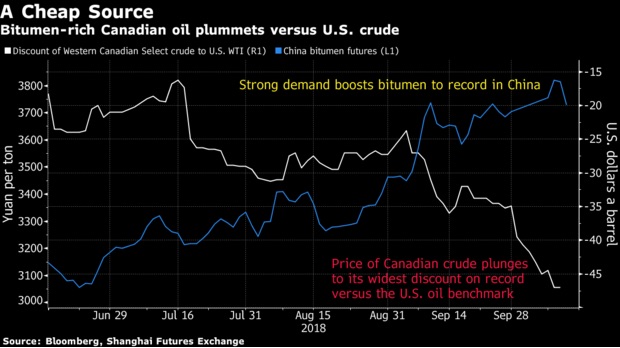
It’s estimated that Canadian oil producers lose $40 million a day due to the discount caused by the glut of Alberta oil and lack of new pipelines.
Compounding the pipeline problem is a lack of investment confidence in the sector. A number of international companies have left, or significantly reduced their stakes, including Total, Statoil, Murphy Oil Corp, Royal Dutch Shell/ Marathon Oil, and ConocoPhillips.
Between 2016 and 2017 Canadian oil companies paid over $31 billion for oil sands acquisitions, leaving almost three-quarters of oil sands production in just four companies: Imperial Oil, Suncor, Cenovus and Canadian Natural Resources, according to the Calgary Herald. The foreign firms say they can’t make enough money in the sands due to low oil prices (a less potent argument now), high costs and pressure from environmental groups.
The last major oil sands project to go into production was Suncor’s Fort Hills, in 2017. The $17-billion JV between Suncor, Teck Resources and Total has a capacity of 194,000 barrels a day and is expected to ramp up to 90% of that by the end of the year.
Suncor’s CEO, Steve Williams, said that Fort Hills won’t be the last oil sands mine that the company builds, but unless there is a sea-change in the Alberta oil patch (Ie. more pipelines to relieve the glut and the WCS discount), it certainly will be.
There appears to be a policy shift, either directly or indirectly, at the provincial and federal government levels, that natural gas is the way forward, and the oil sands shouldn’t be encouraged to expand. Natural gas is seen as cleaner than oil, particularly when it is transported. A natural gas spill is invisible (though no less damaging to the environment); an oil spill evokes ghastly images of ruined beaches, dead seals and oily sea birds. This partly explains the enthusiasm with which the BC premier and the Canadian prime minister greeted the LNG Canada decision. It is more politically palatable. Unlike the disastrous Kinder Morgan pipeline, politicians don’t expect major protests against a natural gas pipeline.
But we need to recognize that the idea of natural gas being safer than oil is an illusion. The 2015-16 natural gas leak at Alison Canyon, California, is now on record as being the worst man-made greenhouse gas disaster in US history. The 112-day leak spewed about 5 billion cubic feet of methane into the atmosphere. The rupture of a natural gas transmission pipeline owned by Enbridge, near Prince George earlier this week, caused a huge fire and the evacuation of 100 people. More importantly, the leak had Fortis BC asking customers to reduce their gas use – a reminder that natural gas doesn’t always flow uninterrupted. Users are vulnerable to accidents.
Oil companies are also getting behind natural gas, co-opting the idea that NG is “green” energy and part of the solution to global warming. In a recent Reuters article, Big Oil companies Shell, BP and Total are playing to the public mood by investing more in renewable energies, electric vehicle technology and even forestation. While cleverly showing a benevolent side to its opponents, however, these companies also suggest a leopard doesn’t change its spots.
“Shell’s core business is, and will be for the foreseeable future, very much in oil and gas… and particularly in natural gas,” Shell CEO Ben van Beurden said in a speech at the Oil & Money conference.
And why wouldn’t they? By 2035, van Beurden sees global gas demand growing 2% a year, double the pace of world energy demand, Reuters reports, adding that natural gas currently represents about 22% of the global energy mix.
This despite an alarming UN report last week saying that limiting the temperature of the Earth to a 1.5-degree rise means that people will have to immediately change the way they use energy, read fossil fuels, to avoid environmental catastrophe.
Closer to home, the Canadian energy industry is also pinning its hopes on LNG for an oil patch revival.
“If you get one plant through, you’ll get a second and third plant to follow much easier,” Steve Laut, vice chairman of Canadian Natural Resources Ltd., one of the country’s largest natural gas producers, told Bloomberg. “It gives confidence to the other proponents.”
Bloomberg notes the project is the biggest new liquefied natural gas facility approved globally since Russia’s Yamal project in 2013.
The Financial Post chimed in that LNG Canada – the first gas export project commissioned in Canada – should help the Canadian NG sector, which has seen depressed prices for years. Like oil, the solution is to build gas pipelines to relieve the glut, which also like oil, is sold at a discount to US gas.
Alberta sour grapes
The hypocrisy of the BC government embracing LNG, while giving the cold shoulder to oil, resonates most in Alberta, the engine of the Canadian oil industry. Why is LNG Canada going ahead while the Trans Mountain pipeline expansion is tied up in more consultation? An Alberta Cabinet minister says the LNG project will have a greater environmental impact than TMX. We agree.
“It’s going to result in about 177-per-cent increase in tanker traffic compared to TMX which will result in a 14 per cent increase,” Economic Development and Trade Minister Deron Bilous told reporters at the Alberta legislature, via CBC.
A Globe and Mail article on the weekend put the two projects side by side to examine the impacts – both economic and environmental. In terms of CO2 emissions, the Globe analysis assigns a much heavier footprint to LNG Canada – 3.45 million tonnes annually – versus just 0.4 million tonnes from TMX.
BC Premier “comfortable with fracking”
While we’re talking politics, we must emphasize that the BC NDP buying into the BC Liberal LNG plan is another example of misguided NDP policy. While in Opposition, then-NDP leader Adrian Dix went along with LNG because the NDP was afraid of losing rural votes, even though most of their urban constituency opposed it. John Horgan, now Premier, was the NDP energy critic before the 2013 election. In 2012, he was asked what he thought of fracking and LNG.
“Very good news,” Horgan responded regarding Shell Canada’s decision to move forward on a new natural gas pipeline to Kitimat. “I’m pretty excited about it. Shell’s a big deal. They’ve got gas that they want to get out of the ground, and they want to get it to a market where they can get a better return than they do in North America.”
When pressed on whether the NDP supports fracking, Horgan had this to say:
“People within the NDP predisposed to green, environmental concerns were troubled that you heard from other jurisdictions where people were lighting their taps on fire because the gas had seeped into aquifers and into the water tables.
“That’s not the case in B.C. Our deposits are three and four kilometres under the ground. In Pennsylvania, the Marcellus play, which is providing gas now to much of Eastern Canada – that’s very shallow, relative to our deposits.”
“We’ve been fracking in B.C. for decades and we do it fairly well. I’ve been to a number of frack sites, and I’m comfortable with the technology.”
So comfortable that some, including David Suzuki, are suggesting that Horgan’s NDP government approved the $10.7 billion Site C dam last year, knowing that it would be needed to power LNG Canada. It’s a charge the government denies.
When we here at Ahead of the Herd are trying to get to the real underlying cause of things we always follow the money – Site C being built to help provide electricity to power the LNG plants, Kinder Morgan being cancelled, you have only so many pipeline routes thru mountainous BC and a $5.3 billion tax break all point in one direction.
Comfortable with fracking. The ridiculousness of that statement will be laid thread-bare below. But first, be reminded that this is the same NDP party that is responsible for the pine beetle epidemic that has destroyed hundreds of thousands of hectares of forests in BC. It started back in the 1980s and 90s, and has led to the appalling condition of our forests, that every year are lit on fire like a box of dry kindling.
Recall also that this BC NDP government, along with environmental groups and First Nations, so vehemently opposed the Kinder Morgan pipeline, even trying to get it overturned in court despite lacking the constitutional authority to do so (and knowing it), and causing a major rift with Alberta. The same pipeline whose opposition to it is being funded by huge US foundations like Tides and the Rockefeller Brothers Fund. The NDP opposition to the Trans Mountain pipeline expansion most certainly paved the way for LNG Canada. With oil pipelines dead in BC, attention turned to natural gas.
The Montney
So where is all this natural gas going to come from? Since most of BC’s conventional NG has already been extracted, all that’s left is tight gas – trapped deep underground in shale bedrock. The only way to get at tight gas is to use hydraulic fracturing to coax the gas to surface. In other words, fracking.
Hydraulic fracturing involves drilling a well then injecting it with a slurry of water, chemical additives and proppants. Wells are drilled and lined with a steel pipe that’s cemented into place. A perforating gun is used to shoot small holes through the steel and cement into the shale. The highly pressurized fluid and proppant mixture injected into the well escapes and creates fractures in the surrounding shale layers, and that stimulates the flow of natural gas or oil. The proppants (grains of sand, ceramic beads, or sintered bauxite) prevent the fractures from closing when the injection is stopped and the pressure of the fluid is removed.
In BC, we’re already fracking in the gas fields of northeastern BC (more on that below), but it’s really only just beginning. That’s because the major source of tight gas in British Columbia, the Montney Formation, is largely untapped.
The Montney is huge. Picture a football-shaped diagonal that starts in BC and extends 130,000 square kilometres into northwest Alberta. The National Energy Board estimates the Montney contains 90 million barrels of oil equivalent, most of it natural gas. It is comparable in size to the major shale gas plays in the United States, including the Marcellus, Utica and Eagle Ford. (see graphic below)
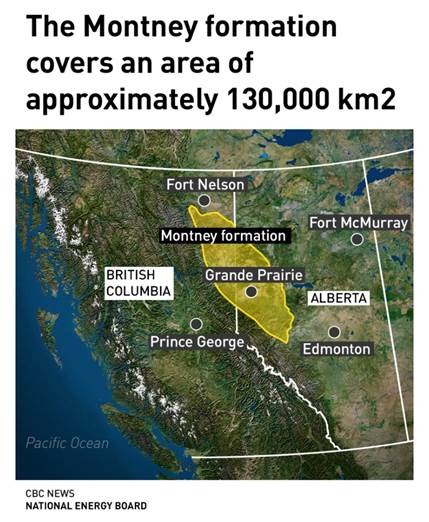
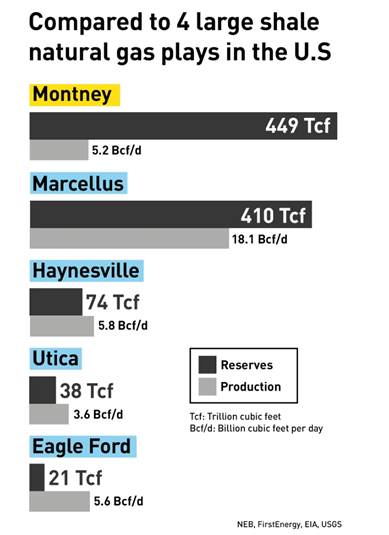
Output from the Montney currently represents a third of Western Canadian gas production, which is double the output since 2012. By 2040 the NEB thinks more than half of Canadian gas will be coming out of the formation, which is a stratigraphical unit of Lower Triassic age in the Western Canadian Sedimentary Basin. Oil and gas companies are pouring into the area.
The evolution of fracking technology has meant that Montney drillers are now able to tap zones of between 100 and 300 meters thick, versus 5 meters a decade ago.
An unconventional poisoning
Over the last several years there’s been a dramatic rise in the use of hydraulic fracturing, mostly in the United States, as the big shale fields get tapped and the price of natural gas has fallen to the point where it now out-competes coal.
As use of this technology has increased worries are growing about fracking’s effect on our fresh water supply; it’s easy to see why:
- Fracking just one well can use 2 to 8 million gallons of water with the major components being water (90%), sand or proppants (8-9.5%), and chemicals (0.5-2%). One 4-million-gallon fracturing operation would use from 80 to 330 tons of chemicals and each well will be fracked numerous times. Many of these chemicals have been linked to cancer, developmental defects, hormone disruption, and other conditions.
- Cracked wells and rock movement frequently leak fracking fluid and gases into nearby groundwater supplies. Fracturing fluid leak-off (loss of fracturing fluid from the fracture channel into the surrounding permeable rock) can exceed 70% of injected volume.
- Methane concentrations are 17 times higher in drinking-water wells near fracturing sites than in normal wells. Hydraulic fracturing increases the permeability of shale beds, creating new flow paths and enhancing natural flow paths for gas leakage into aquifers.

For more on the health and environmental effects of fracking, read our Fracking – An Unconventional Poisoning
Fracking in BC
An examination of the history of fracking and natural gas extraction in northeastern BC reveals a number of disturbing occurrences. Among them: earthquakes; rules to protect caribou were broken and unenforced by the Oil and Gas Commission; unsustainable (and possibly illegal) draw-downs of water; and the most disturbing of all, heightened levels of benzene, a dangerous carcinogen, found in pregnant native women.
Caribou
An alarming decline in the population of the boreal caribou, possibly related to oil and gas extraction in northeastern BC, prompted the BC government in 2011 to create a recovery plan. The federal government had declared the boreal caribou a threatened species. The plan included increased rules that energy companies should follow in order to protect the caribou herds. But an audit that looked at how o&g activities around the Fort Nelson area stacked up against the new rules, found that companies repeatedly broke the rules – including constructing well pads too large, and building roads in long, straight lines that allow wolves to easily spot the caribou. The audit was submitted to the Oil and Gas Commission, which sat on it for four years; a copy was passed to the Canadian Centre for Policy Alternatives (CCPA), which went public with it.
Earthquakes
The link between fracking/ wastewater injection and earthquakes has been strenuously denied by the industry. But a study published in 2016 found that both fracking wells and wastewater disposal wells, increase seismicity. Researchers “compared the relationship of 12,289 fracking wells and 1,236 wastewater disposal wells to magnitude 3 or larger earthquakes in an area of 454,000 square kilometers near the border between Alberta and British Columbia, between 1985 and 2015,” explained a press release. They “found 39 hydraulic fracturing wells (0.3% of the total of fracking wells studied), and 17 wastewater disposal wells (1% of the disposal wells studied) that could be linked to earthquakes of magnitude 3 or larger.”
The same year the BC Oil and Gas Commission confirmed that fracking caused a 4.6-magnitude earthquake at a project operated by Progress Energy, that would supply gas to the now-cancelled Pacific NorthWest LNG terminal in Prince Rupert.
Government cover-up
It gets worse. There is evidence of a government cover-up of the risk fracking presents to dam safety. The CCPA’s Ben Parfitt in 2016 filed a Freedom of Information request with BC Hydro, asking the Crown corporation whether fracking could trigger earthquakes that cause Peace River dams to collapse.
The documents released by BC Hydro under the FOI showed that BC Hydro officials in 2009 became alarmed at a coal-bed methane operation near its Peace Canyon Dam – 23 km downstream from the W.A.C. Bennett Dam, the world’s seventh largest hydro reservoir. The operation involved drilling and fracking coal-bed methane wells to increase their permeability.
“BC Hydro believes that there are immediate and future potential risks to BC Hydro’s reservoir, dam and power generation infrastructure as a result of this,” Parfitt quotes BC Hydro’s former chief safety, health and environment officer, Ray Stewart. From Parfitt’s article:
Stewart went on to warn that the “potential effects” of such actions could be natural gas industry-induced earthquakes that were greater in magnitude “than the original design criteria for the dam.”
What this means, is that the BC government has known since 2009 about the earthquake risks caused by fracking, yet did nothing. Parfitt writes:
“Senior BC Hydro officials have quietly feared for years that earthquakes triggered by natural gas industry fracking operations could damage its Peace River dams, putting hundreds if not thousands of people at risk should the dams fail. Yet the Crown corporation has said nothing publicly about its concerns, opting instead to negotiate behind the scenes with the provincial energy industry regulator, the BC Oil and Gas Commission.”
Water
Each well uses between 2 and 8 million gallons of locally-sourced fresh water which will be permanently contaminated by toxic chemicals contained in the fracking fluid, in ground contaminants and the mixing of the two to create new toxic substances.
Millions of gallons of fresh water are getting sucked daily from hundreds of BC creeks, rivers and lakes under permits granted to the gas industry. Local populations affected are fighting back. In 2015 the Fort Nelson First Nation succeeded in overturning a water license granted to Nexen that would have allowed the company to pump water from Tsea Lake.
The year earlier, “A pair of environmental groups allege the British Columbia government is skirting its own laws by allowing energy firms to spend years using large quantities of fresh water for natural gas extraction without having to go through the rigorous process of applying for long-term water licences,” reads a news story by The Canadian Press.
Benzene poisoning
Up to now the health risks of northern BC’s shale gas operations have only been theoretical. But a 2017 study at the University of Montreal found that fracking releases volatile organic compounds (VOCs) like benzene into the environment.
Benzene is a known carcinogen that causes cancer and other illnesses include bone marrow failure. The American Petroleum Institute (API) said in 1948 that “it is generally considered that the only absolutely safe concentration for benzene is zero.”
The results of the study, which build on similar American research, are truly scary. Here’s an excerpt from a writeup about the study:
The researchers tested urine samples of 29 pregnant women in Chetwynd and Dawson Creek, two small communities near heavily-fracked shale gas fields in BC’s Peace River Valley. They measured two “biomarkers” that our bodies produce when we’re exposed to benzene, a carcinogen that’s been linked to low birth weights and some defects.
[Study co-author] Caron-Beaudoin says her team found the women’s urine samples had 3.5 times more of these biomarkers than the average Canadian. Of the women who identified as Indigenous, those markers were six times more concentrated.
Given what we know about fracking, has the BC government and communities affected by it raised the alarm? Apparently not. In September the Union of BC Municipalities rejected a call to put a moratorium on fracking until it is proven safe. Quebec has banned the practice, along with the Yukon and the Maritimes.
For its part, the province has launched a scientific review of fracking – led by a three-member panel of university professors – who will investigate fracking’s relationship to earthquakes, its impacts on water quality and fugitive methane emissions.
BC Green Party MLA Sonia Fursteneau dismissed the panel as a waste of time, since the effects of fracking are already widely known.
“There is plenty of evidence to indicate that fracking is neither safe nor environmentally responsible. This panel is unnecessary; government staff could review the literature themselves and take appropriate action,” she said in a statement quoted by the Globe and Mail.
Green Party leader Andrew Weaver has called for a moratorium on fracking since 2016 – after the aforementioned study was released showing the connection between fracking and earthquakes.
Fracking and LNG
So far we’ve looked at all the negative effects of fracking, but how does fracking relate to LNG? Well, since the only remaining natural gas in BC is accessible through hydraulic fracturing in tight gas plays like the Montney Formation, it follows that all the NG for LNG Canada and any future LNG project will have to come from fracked gas wells.
But there’s a problem other then expanding existing pipelines and building new ones to carry all that gas. The gas, when it arrives at the terminal, is unsuitable for transport. To turn it into a liquid, it must be cooled to 163 degrees below zero. To do that requires a great deal of power, with massive compression units running 24/7. The question is, how will they source the power? It’s estimated that if LNG Canada were to use only hydro-electric power to convert NG to LNG, would require 40% of the capacity of the Site C dam currently being built. The more likely scenario is that LNG Canada will use a combination of hydro electricity and natural gas to power the plant – the same fracked gas that came via pipeline to the terminal. And it makes sense to do that, since NG is a lot cheaper than hydro.
“Arctic cauldron” of methane
Natural gas is often described as “clean-burning”, but the reality is it’s far from it. While it’s true that NG when burned emits less carbon say, than coal, it also emits methane – an exceedingly potent greenhouse gas that warms the atmosphere more than carbon dioxide.
Natural gas is mostly methane (CH4), and methane is over 25 times more efficient than carbon dioxide at trapping heat in the atmosphere over a 100-year period. (the Intergovernmental Panel on Climate Change (IPCC) says methane is 86 times more damaging than CO2 over a 20-year period)
In August of 2013, a National Oceanic and Atmospheric Administration (NOAA)- led study measured a stunning 6% to 12% methane leakage over one of the US’s largest gas fields, the Uintah Basin, which produces about 1% of US natural gas.
The Journal Nature measured two locations in Colorado and Utah and found methane leakage ranging from 4 to 9%.
Here in BC, methane emissions from British Columbia’s natural gas industry are likely at least 7 times greater than official numbers, due to “fugitive emissions” that escape somewhere between the extraction and the gas’s destination.
The Sierra Club notes the situation will get even worse, after Site C:
When the Site C reservoir is flooded, the dead biomass from the vegetation that once covered the area will rot, emitting a huge amount of methane into the atmosphere. The extraction, treatment and piping of fracked gas also releases much more methane that we previously thought, in the form of “fugitive emissions.” And methane is a potent greenhouse gas.

Indeed the escape of huge amounts of methane after the permafrost has melted in the Arctic is a key feedback loop we have previously identified as being a major accelerant of global warming.
For more read our Climate Armageddon
In a feature article, The Washington Post illustrates how an “Arctic cauldron” was discovered by a graduate student who has studied some 300 lakes dotted across the Arctic tundra. But this lake was different.
Set against the austere peaks of the Western Brooks Range, the lake, about 20 football fields in size, looked as if it were boiling. Its waters hissed, bubbled and popped as a powerful greenhouse gas escaped from the lake bed. Some bubbles grew as big as grapefruits, visibly lifting the water’s surface several inches and carrying up bits of mud from below.
This was methane.
As the permafrost thaws across the fast-warming Arctic, it releases carbon dioxide, the top planet-warming greenhouse gas, from the soil into the air. Sometimes, that thaw spurs the growth of lakes in the soft, sunken ground, and these deep-thawing bodies of water tend to unleash the harder-hitting methane gas.
Studying the huge lake, which is only around three feet deep, the scientists learned that in places the lake contains “pockets” that drop down to 50 feet. These are methane vents. The methane appears to come not directly from the permafrost (frozen Arctic soil), but from “a reservoir of far older fossil fuels.” These fossil fuels – the result of generations of dead plants that sank beneath the Earth’s surface – were buried for thousands of years. The cold preserved them, and now that it’s warming up, they are coming back to life, in the form of greenhouse gases.
A Mexican scientist also studying the lake found it was producing two tons of methane gas per day – the same amount of methane gas that would be farted from about 6,000 dairy cows.
In an earlier published study, Katey Walter Anthony and her husband, also a scientist, warned of the dangers of thermokarst lakes, which form when the permafrost melts.
[T] hey found that the continuing growth of these lakes — many of which have already formed in the tundra — could more than double the greenhouse gas emissions coming from the Arctic’s soils by 2100. That’s despite the fact that the lakes would cover less than 6 percent of the total Arctic land surface.
This could be a key reason why atmospheric methane levels since 2006 have averaged 25 million tons more per year.
According to the article, if Walter Anthony’s findings are correct, the impact of thawing permafrost could mean the equivalent adding two more Germany’s to the planet in terms of carbon emissions. And that doesn’t count the existence of the strange Arctic cauldrons which emit methane at a much faster rate.
Similar bubbling lakes have been found in the tropics.
Conclusion: head for the hills
It should be apparent after reading this article that there is no way the BC government is going to be able to meet its climate change goals by approving LNG Canada while rejecting the Trans Mountain pipeline. The province has committed to cutting greenhouse gases by 40% by 2030 (and 80% by 2050) but LNG Canada would produce 3.45 megatonnes of carbon a year. And that’s only with the first two trains. Recall the plan is to have four trains, doubling the gas output. According to the Pembina Institute, that means BC will only be able to emit 13 megatonnes of carbon by mid-century. To accomplish that would mean massive cuts to carbon emission elsewhere. It ain’t gonna happen, folks.
We already know that the planet is warming inexorably, and there is no stopping it. Ocean temperatures are rising, Arctic ice and glaciers are disappearing, and permafrost is melting. Droughts and forest fires are intensifying. Storms are getting stronger and more frequent. We know now that the three powerful hurricanes last year were caused by warmer oceans.
But spewing more pollution into the air by burning methane-containing natural gas to supercool fracked natural gas so we can ship liquefied gas to Asia is not the way to go. On top of that, we have the poisoning of the fresh water supply from fracking, and downstream health effects, including proven levels of benzene in pregnant women whose effects will be passed onto their babies. There’s also earthquakes, possible burst dams, and the depletion of billions of gallons of fresh water that will never be recovered.
What are we doing?
The politicians, the same ones who blocked Kinder Morgan on environmental grounds, are the ones driving this, so the only way for the average person to deal with it is to be prepared. Bloomberg Businessweek asks: Can modern society prepare for a world in which global warming threatens large-scale social, economic, and political upheaval? What are the policy and social implications of rapid, and mostly unpleasant, climate disruption?
Once the purview of doomsday cults and crackpots living in the woods, these questions are now being asked by real scientists.
The practical answer is to do things like building walls to stop storm surges and the encroaching, rising sea – something New York City and Louisiana are considering.
But these are really just band-aids. The real answer, if there is one, is more far-reaching and elemental. Some are calling it the “deep adaptation agenda”. It could mean “not only rapid decarbonization and storm-resistant infrastructure, but also building water and communications systems that won’t fail if the power grid collapses and searching for ways to safeguard the food supply by protecting pollinating insects,” states Bloomberg.
This is the stuff of armageddon movies, but it is likely where we’re heading:
Propelling the movement are signs that the problem is worsening at an accelerating rate. In an article this summer in the Proceedings of the National Academy of Sciences, 16 climate scientists from around the world argued that the planet may be much closer than previously realized to locking in what they call a “hothouse” trajectory—warming of 4C or 5C (7F or 9F), “with serious challenges for the viability of human societies.”
Jem Bendell, a professor at the University of Cumbria who popularized the term deep adaptation, calls it a mix of physical changes—pulling back from the coast, closing climate-exposed industrial facilities, planning for food rationing, letting landscapes return to their natural state—with cultural shifts, including “giving up expectations for certain types of consumption” and learning to rely more on the people around us.
“The evidence before us suggests that we are set for disruptive and uncontrollable levels of climate change, bringing starvation, destruction, migration, disease and war,” he wrote in a paper he posted on his blog in July after an academic journal refused to publish it. “We need to appreciate what kind of adaptation is possible.”
Are you concerned about BC’s shift toward natural gas development, including fracking and all its consequences, chucking out climate change goals and accelerating the destruction of the planet? If not, you should be. We all have to be.
Richard (Rick) Mills
Ahead of the Herd is now on Twitter.
Ahead of the Herd is now on FaceBook
Ahead of the Herd is now on YouTube
Legal Notice / Disclaimer
This document is not and should not be construed as an offer to sell or the solicitation of an offer to purchase or subscribe for any investment.
Legal Notice / Disclaimer
Ahead of the Herd newsletter, aheadoftheherd.com, hereafter known as AOTH.Please read the entire Disclaimer carefully before you use this website or read the newsletter. If you do not agree to all the AOTH/Richard Mills Disclaimer, do not access/read this website/newsletter/article, or any of its pages. By reading/using this AOTH/Richard Mills website/newsletter/article, and whether you actually read this Disclaimer, you are deemed to have accepted it.



